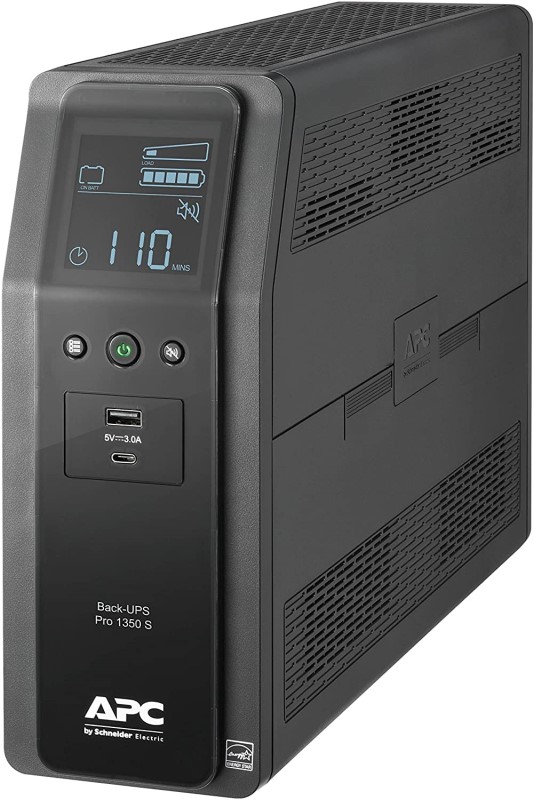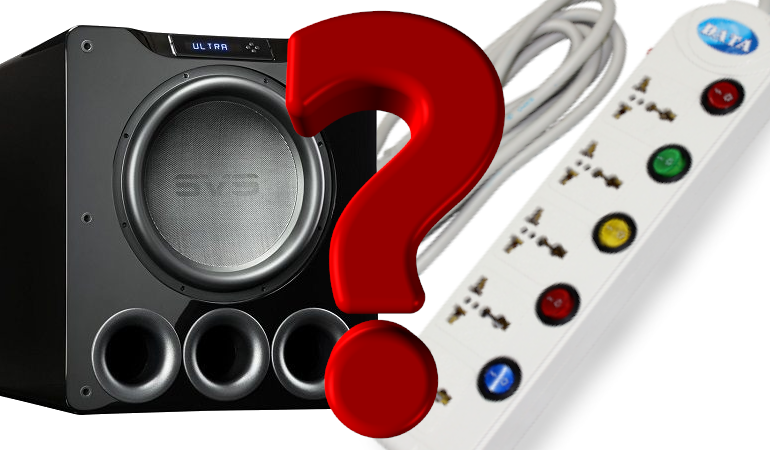Should I Plug My Subwoofer Into a Surge Protector?
Surge protectors are a good thing. In the event of some sort of electrical catastrophe, they protect your gear. These are (nearly always) sacrificial devices. The surge comes in, the surge protector recognizes it and then sacrifices itself to protect your gear. Replacing a $20 surge protector is way better than replacing all your AV and home theater gear (or PC or TV or…you get the idea). But what about your home theater subwoofer? Should you plug your subwoofer into a surge protector? It’s an expensive piece of electrical gear so the answer would seem to be “yes.” But you’d be wrong. Let us explain.
Author’s Note: For a more complete discussion of how surge protectors work, check out this interview with Charlie Jones on the AV Rant podcast.
The Problem With Surge Protectors and Subwoofers
Surge protectors stop your gear from getting fried by power fluctuations or lightning strikes. That’s why we all buy them. We’d rather replace the surge protector than the gear that is plugged into it. That’s understandable. But if you read any literature about subwoofers (including many of the manuals that arrive with your sub), you’ll see that oftentimes they state clearly that you shouldn’t plug your subwoofer into a surge protector.
That seems counterintuitive. Why not? Doesn’t your subwoofer need to be protected as well?
Subwoofers Have Built-In Protection
The fact is that most of them are. They usually have some sort of circuitry or fuse that will do the same job as a surge protector. With these systems in place, a surge protector is redundant.

More than that, however, are the problems you can sometimes encounter when plugging your subwoofer into a surge protector. Most surge protectors limit the amount of current that can pass through them. Your subwoofer, unfortunately, often needs every bit of power that is available at the wall. If your surge protector limits the current, the sub and the protector get into a sort of “war.” The sub continually tries to pull more power while the protector constantly tries to limit the flow. Eventually, one (or both) will break in the attempt.
Many subwoofer manuals will either tell you not to use a surge protector or to only plug the sub into an outlet that provides a certain amount of power. This is almost always more power than most protectors will allow through.

What About the Rest of Your Gear
You are probably wondering about the rest of your gear. If the subwoofer has a built-in protection solution, does that also protect the rest of your gear? The answer is…maybe? Probably? We really can’t say with any certainty. We can say they certainly aren’t going to warranty any of the rest of your gear. You can see this clearly in their owner’s manuals which almost always include some verbiage that says you should unplug your subwoofer if you aren’t going to use it for a while or when there is a lightning storm.
Yes, we are aware that no one does that.
So, what is the solution? Well, we generally recommend that people NOT plug their subwoofer into a surge protector. We’ve experienced too many problems with that arrangement. We’ve also found that most (if not all) of the subwoofers we recommend have been extremely robust. I live in Florida where lightning storms and power outages are a way of life. I’ve never had a subwoofer fail because of a lightning strike or surge. But I may just be lucky.
Be Prepared to Make Some Calls
In the end, it will be up to you. If you really want to plug your subwoofer into some sort of surge protector, be prepared to do some research. Talk with your subwoofer manufacturer. Contact the surge protector company. You’ll need to make sure that the protector can allow through all the power that the subwoofer might need.
And then be prepared to spend some money.
The off-the-rack surge protectors are not going to allow enough power through their plugs for your subwoofer. You can bet on that. You are going to need something a little beefier. And that is going to take some cash.



So why are there half a dozen other reputable websites and forums (the household name ones to us Hi-Fi enthusiasts) online that suggest that you should? They are split between plugging it in the same surge protector (a quality one) or it’s own surge protector. I’m pretty well versed when it comes to I find Electronics but not so much when it comes to electrical issues. So this is extremely confusing to consumers who find reputable sources conflicting with each other….
In all cases, call the manufacturer when in doubt. You’ll find that they most often agree with me.
I’m a pretty experienced audiophile. Music and home theatre is my life. Subwoofers, need the power, the direct power, non filtered. Subwoofers have there own built in ” protectors ” or so to say that need the direct power to function proper as per the article articulated. Televisions, receivers, they can benifit from a power conditioner/surge protector. Even with my experience I still question the benifits my Avr would get from a conditioner. Receivers like subwoofers have there own circuits wired for direct current as well. My point being from experience low dollar conditioners do nothing but potentially cause issues. My advice, use your own better judgement. The human ear will bairily notice a difference of any sound unless your using a high end sound reproduction room with proper aquistics. The room makes the most difference. Respect to all audio enthusiasts who try these options, live and learn.
Most surge protectors only shunt current if the voltage spikes. There are exceptions with conditioners but no way is a simple surge protector going to do anything about current if the voltage is below 130v. Just try to make a current limiter using MOVs and you’ll see.